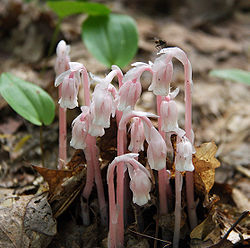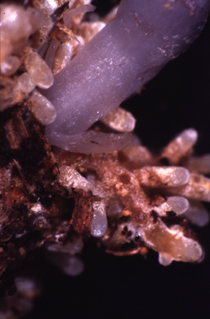
Myco-heterotrophy
Encyclopedia

Parasitism
Parasitism is a type of symbiotic relationship between organisms of different species where one organism, the parasite, benefits at the expense of the other, the host. Traditionally parasite referred to organisms with lifestages that needed more than one host . These are now called macroparasites...
upon fungi rather than from photosynthesis
Photosynthesis
Photosynthesis is a chemical process that converts carbon dioxide into organic compounds, especially sugars, using the energy from sunlight. Photosynthesis occurs in plants, algae, and many species of bacteria, but not in archaea. Photosynthetic organisms are called photoautotrophs, since they can...
. A myco-heterotroph is the parasitic plant
Parasitic plant
A parasitic plant is one that derives some or all of its sustenance from another plant. About 4,100 species in approximately 19 families of flowering plants are known. Parasitic plants have a modified root, the haustorium, that penetrates the host plant and connects to the xylem, phloem, or...
partner in this relationship. Myco-heterotrophy is considered a kind of cheating
Cheating (biology)
Cheating is a metaphor commonly used in behavioral ecology to describe organisms that receive a benefit at the cost of others. Cheating is common in many mutualistic and altruistic relationships. Natural selection favors cheating, but there are mechanisms to regulate cheating.- Theoretical Models...
relationship and myco-heterotrophs are sometimes informally referred to as "mycorrhizal cheaters". This relationship is sometimes referred to as mycotrophy, though this term is also used for plants that engage in mutualistic mycorrhizal relationships.
Relationship between myco-heterotrophs and host fungi

Chlorophyll
Chlorophyll is a green pigment found in almost all plants, algae, and cyanobacteria. Its name is derived from the Greek words χλωρος, chloros and φύλλον, phyllon . Chlorophyll is an extremely important biomolecule, critical in photosynthesis, which allows plants to obtain energy from light...
or otherwise lacking a functional photosystem
Photosystem
Photosystems are functional and structural units of protein complexes involved in photosynthesis that together carry out the primary photochemistry of photosynthesis: the absorption of light and the transfer of energy and electrons...
) gets all of its food from the fungi that it parasitizes. Partial (or facultative) myco-heterotrophy exists when a plant is capable of photosynthesis, but parasitizes fungi as a supplementary food supply. There are also plants, such as some orchid species, that are non-photosynthetic and obligately myco-heterotrophic for part of their life cycle
Biological life cycle
A life cycle is a period involving all different generations of a species succeeding each other through means of reproduction, whether through asexual reproduction or sexual reproduction...
, and photosynthetic and facultatively myco-heterotrophic or non-myco-heterotrophic for the rest of their life cycle. Not all non-photosynthetic or "achlorophyllous" plants are myco-heterotrophic – some non-photosynthetic plants like dodder
Cuscuta
Cuscuta is a genus of about 100-170 species of yellow, orange or red parasitic plants. Formerly treated as the only genus in the family Cuscutaceae, recent genetic research by the Angiosperm Phylogeny Group has shown that it is correctly placed in the morning glory family, Convolvulaceae...
directly parasitize the vascular tissue
Vascular tissue
Vascular tissue is a complex conducting tissue, formed of more than one cell type, found in vascular plants. The primary components of vascular tissue are the xylem and phloem. These two tissues transport fluid and nutrients internally. There are also two meristems associated with vascular tissue:...
of other plants.
In the past, non-photosynthetic plants were mistakenly thought to get food by breaking down organic matter
Organic matter
Organic matter is matter that has come from a once-living organism; is capable of decay, or the product of decay; or is composed of organic compounds...
in a manner similar to saprotrophic fungi. Such plants were therefore called "saprophytes
Saprophytes
Saprophytes may refer to*Saprotroph, a term used for organisms which obtain nutrients from dead organic matter...
". It is now known that no plant is physiologically capable of direct breakdown of organic matter and that in order to get food, non-photosynthetic plants must engage in parasitism, either through myco-heterotrophy or direct parasitism of other plants.
The interface between the plant and fungal partners in this association is between the roots of the plant and the mycelium of the fungus. Myco-heterotrophy therefore closely resembles mycorrhiza
Mycorrhiza
A mycorrhiza is a symbiotic association between a fungus and the roots of a vascular plant....
(and indeed is thought to have evolved from mycorrhiza), except that in myco-heterotrophy, the flow of carbon is from the fungus to the plant, rather than vice versa.
Most myco-heterotrophs can therefore be seen as ultimately being epiparasites, since they take energy from fungi that in turn get their energy from vascular plants. Indeed, much myco-heterotrophy takes place in the context of a common mycorrhizal network, in which plants use mycorrhizal fungi to exchange carbon and nutrients with other plants. In these systems, myco-heterotrophs play the role of "mycorrhizal cheaters", taking carbon from the common network, with no known reward.
In congruence with older reports, it has been recently shown that some myco-heterotrophic orchids can be supported by saprotrophic fungi, exploiting litter- or wood-decaying fungi. In addition, several green plants (evolutionarily close to myco-heterotrophic species) have been shown to engage in partial myco-heterotrophy, that is, they are able to take carbon from mycorrhizal fungi, in addition to their photosynthetic intake.
Species diversity of myco-heterotrophs and host fungi
Myco-heterotrophs are found among a number of plant groups. All monotropes and non-photosynthetic orchids are full myco-heterotrophs, as is the non-photosynthetic liverwortMarchantiophyta
The Marchantiophyta are a division of bryophyte plants commonly referred to as hepatics or liverworts. Like other bryophytes, they have a gametophyte-dominant life cycle, in which cells of the plant carry only a single set of genetic information....
Cryptothallus
Cryptothallus
Cryptothallus is a genus of liverworts in the family Aneuraceae. The plants are small, and are white to pale green as a result of lacking chlorophyll. The morphology of Cryptothallus is very similar to that of Aneura...
. Partial myco-heterotrophy is common in the Gentian family, with a few genera such as Voyria
Voyria
Voyria is a genus of nineteen species of herbaceous perennial plants, belonging to the family Gentianaceae. They are mostly native to warm temperate and tropical regions of Central America and South America with one species occurring in the Everglades of Florida.Unlike most plants, they do not...
being fully myco-heterotrophic, in photosynthetic orchids, and a number of other plant groups. Some fern
Fern
A fern is any one of a group of about 12,000 species of plants belonging to the botanical group known as Pteridophyta. Unlike mosses, they have xylem and phloem . They have stems, leaves, and roots like other vascular plants...
s and clubmosses have myco-heterotrophic gametophyte
Gametophyte
A gametophyte is the haploid, multicellular phase of plants and algae that undergo alternation of generations, with each of its cells containing only a single set of chromosomes....
stages. The fungi that are parasitized by myco-heterotrophs are typically fungi with large energy reserves to draw on, usually mycorrhizal fungi, though there is some evidence that they may also parasitize parasitic fungi that form extensive mycelial networks, such as Armillaria.
Examples of fungi parasitized by myco-heterotrophic plants can be found among the ectomycorrhizal, arbuscular mycorrhizal, and orchid mycorrhizal fungi. The great diversity in unrelated plant families with myco-heterotrophic members, as well as the diversity of fungi targeted by myco-heterotrophs suggests multiple parallel evolution
Parallel evolution
Parallel evolution is the development of a similar trait in related, but distinct, species descending from the same ancestor, but from different clades.-Parallel vs...
of myco-heterotrophs from mycorrhizal ancestors.
Further reading
- Hershey DR. 1999. Myco-heterophytes and parasitic plants in food chains. American Biology Teacher 61: 575–578.
- Hibbett DS. 2002. When good relationships go bad. NatureNature (journal)Nature, first published on 4 November 1869, is ranked the world's most cited interdisciplinary scientific journal by the Science Edition of the 2010 Journal Citation Reports...
419: 345–346. - Werner PG. 2006. Myco-heterotrophs: hacking the mycorrhizal network. Mycena News 57(3): 1,8.
- Dr. Martin Bidartondo: Selected publications
- D. Lee Taylor Lab: Recent Publications
- M.-A. Selosse's publications
External links
- The Strange and Wonderful Myco-heterotrophs The Parasitic Plant Connection, SIU CarbondaleSouthern Illinois University CarbondaleSouthern Illinois University Carbondale is a public research university located in Carbondale, Illinois, United States. Founded in 1869, SIUC is the flagship campus of the Southern Illinois University system...
, College of Science. - Wayne's Word Noteworthy Plant For June 1997: Fungus Flowers – Flowering Plants that Resemble Fungi by WP Armstrong.
- Fungus of the Month for October 2002: Monotropa uniflora by Tom Volk, TomVolkFungi.net
- Martín's Treasure Chest – images of myco-heterotrophs by mycologist Martín Bidartondo.

